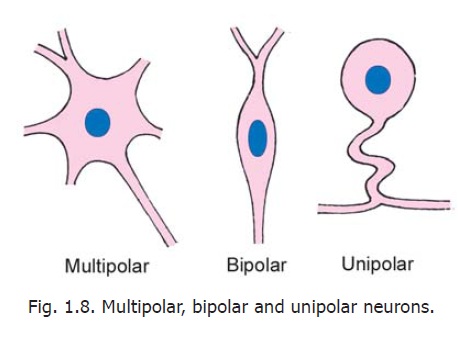Chapter: Human Neuroanatomy(Fundamental and Clinical): Introduction to Neuroanatomy
Variability in Neuron Structure
Variability in Neuron Structure
Variation in the shape of neuronal cell bodies
Neurons vary considerably in the size and shape of their cell bodies (somata) and in the length and manner of branching of their processes. The cell body varies in diameter from about 5 μm, in the smallest neurons, to as much as 120 μm in the largest ones. The shape of the cell body is dependent on the number of processes arising from it. The most common type of neuron gives off several processes and the cell body is, therefore, multipolar (Fig. 1.8). Some neurons have only one axon and one dendrite and are bipolar.

Another type of neuron has a single process (which is highly convoluted). After a very short course this process divides into two. One of the divisions represents the axon; the other is functionally a dendrite, but its structure is indistinguishable from that of an axon. This neuron is described as unipolar, but from a functional point of view it is to be regarded as bipolar. (To avoid confusion on this account this kind of neuron has been referred to, in the past, as a pseudounipolar neuron but this term has now been discarded). Depending on the shapes of their cell bodies some neurons are referred to as stellate (star shaped) or pyramidal.
In addition to the variations in size and shape, the cell bodies of neurons may show striking variations in the appearance of the Nissl substance. In some neurons, the Nissl substance is very prominent and is in the form of large clumps. In some others, the granules are fine and uniformly distributed in the cytoplasm, while yet other neurons show gradations between these extremes. These differences are correlated with function.
Variations in axons
The length of the axon arising from the cell body of a neuron is also subject to considerable variability. Some neurons have long axons, and connect remote regions. These are called Golgi type I neurons. In other neurons axons are short and end near the cell body. They are called Golgi type II neurons or microneurons: these are often inhibitory in function. Very rarely, a neuron may not have a true axon.
As stated earlier, axons also differ in the nature of the sheaths covering them, some of them being myelinated and others unmyelinated. Axons also show considerable variation in the diameter of their cross sections.
Variations in dendrites
Dendrites arising from a neuronal cell body vary considerably in number, and in the extent and manner of branching. They also differ in the distribution of spines on them. These characteristics are of functional importance. The area occupied by the dendrites of a neuron is referred to as its dendriticfield. Different kinds of neurons have differing dendritic fields.
Neurons also show considerable variation in the number and nature of synapses established by them.
Related Topics